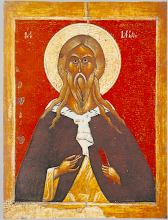Slavery is still very much with us. Don't think it isn't. We need St. Raymond, who is the saint who ransomed slaves. And he was silenced by his enemies, like so many truth speakers now. To quote:
Raymond, universally known as Nonnatus or not born due to his atypical birth, is the Mercedarian saint who achieved the greatest popularity among Christians in the places, kingdoms and nations where Mercedarians became established.
According to the most reliable Mercedarian tradition, Saint Raymond was born in the town of Portello, situated in the Segarra region of the Province of Lérida at the dawn of the thirteenth century. He was given the surname of Nonnatus or not born because he came into the world through an inspired and urgent incision which the Viscount of Cardona made with a dagger in the abdomen of the dead mother. In his adolescence and early youth, Raymond devoted himself to pasturing a flock of sheep in the vicinity of a Romanesque hermitage dedicated to Saint Nicholas where an image of the Virgin Mary was venerated. His devotion to the Holy Mother of Jesus started there.
He joined the Order of Mercy at a very early age. Father Francisco Zumel relates that young Raymond was a “student of the watchful first brother and Master of the Order, Peter Nolasco.” Therefore, Raymond was a redeemer of captives in Moorish lands. In a redemption which took place in Algiers, they had to stay behind as hostages. It was then that he endured the torment of having his lips sealed with an iron padlock to prevent him from addressing consoling words to Christian captives and from preaching the liberating good news of the Gospel. After he had been rescued by his Mercedarian brothers, Pope Gregory IX appointed him Cardinal of the Church of San Eustaquio. Summoned by the Supreme Pontiff, Raymond was on his way to Rome when he met death in the strong and rocky castle of Cardona in 1240. The Order of Mercy, the viscount and the city of Cardona were all arguing over his dead body, and where it should be buried, it was entrusted to Divine Providence on the harness of a blind mule. Without anyone leading it, the mule accompanied by a crowd trotted to Saint Nicholas hermitage where the venerable body was buried. (Read entire post.)

















%2C_chapel_window_4%2C_St_Lawrence.jpg/220px-St._Stephen_the_Martyr_(Omaha)%2C_chapel_window_4%2C_St_Lawrence.jpg)





